Yorkville, Manhattan
Yorkville is a neighborhood in the Upper East Side of Manhattan, New York City. Its southern boundary is East 79th Street, its northern East 96th Street, its western Third Avenue, and its eastern the East River. Yorkville is among the city's most affluent neighborhoods.[3]
Yorkville | |
|---|---|
Neighborhood of Manhattan | |
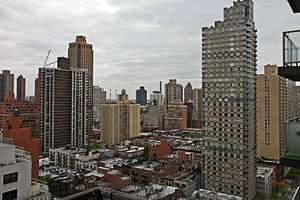 Yorkville, as seen from a highrise on East 87th Street | |

Location in New York City | |
| Coordinates: 40.776°N 73.950°W | |
| Country | |
| State | |
| City | New York City |
| Borough | Manhattan |
| Community District | Manhattan 8[1] |
| Area | |
| • Total | 1.27 km2 (0.492 sq mi) |
| Population (2016)[2] | |
| • Total | 35,221 |
| • Density | 28,000/km2 (72,000/sq mi) |
| Ethnicity | |
| Economics | |
| • Median income | $103,234 |
| Time zone | UTC−5 (Eastern) |
| • Summer (DST) | UTC−4 (EDT) |
| ZIP Codes | 10028, 10075, 10128 |
| Area code | 212, 332, 646, and 917 |
Yorkville is part of Manhattan Community District 8 and its primary ZIP Codes are 10028, 10075, and 10128.[1] It is patrolled by the 19th Precinct of the New York City Police Department.
History

Early history
In August 1776, George Washington stationed half of his Continental Army in Manhattan, with many troops in the Yorkville area in defensive positions along the East River to protect the other half of his army if they were to retreat from Brooklyn, and to inflict damage on invading land and sea forces.[4] Following the Battle of Long Island defeat on August 27, the Continentals implemented an orderly pivoting retreat in the Yorkville area, leading the enemy to entice the Continentals to fight by piping "Fly Away", about a fox running away from hounds. The Continentals' disciplined northerly retreat led to the successful Battle of Harlem Heights in September 1776.[5]
In 1815, the Upper East Side was a farmland and market garden district.[6] The Boston Post Road traversed the Upper East Side, locally called the Eastern Post Road; milepost 6 was near the northeast corner of Third Avenue and 81st Street. From 1833 to 1837 the New York and Harlem Railroad, one of the earliest railway systems in the United States, was extended through the Upper East Side along Fourth Avenue (later renamed Park Avenue).[7] A hamlet grew near the 86th Street station, becoming the Yorkville neighborhood as gradual yet steady commercial development occurred. The current street grid was laid-out between 1839 and 1844 as part of the Commissioners' Plan of 1811, so the Eastern Post Road was abandoned. The community had been referred to as Yorkville before 1867.[8]
By 1850, a significant proportion of the inhabitants of the area were the Germans and the Irish that helped build the Croton Aqueduct.[9] The area was included in the 19th administrative district whose boundaries were 40th and 86th Street.[10] In 1858, trams were built along Second and Third Avenues. After the American Civil War, mansions replaced slums in Yorkville.[10] On December 30, 1878, the IRT Third Avenue Line opened, followed by the IRT Second Avenue Line in August 1879.[11]
Ethnic settlement
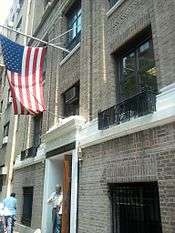
For much of the 19th and 20th centuries, Yorkville was a middle- to working-class neighborhood, inhabited by many people of Czech, Slovak, Irish, Polish, German, Hungarian, and Lebanese descent. The area was a mostly German enclave, though.[12] The neighborhood became more affluent.[13]
From 1880, Yorkville became a destination for German-born immigrants. However, by the 1900s, many German residents moved to Yorkville and other neighborhoods from "Kleindeutschland" (Little Germany) on the Lower East Side after the General Slocum disaster on June 15, 1904. The ship caught fire in the East River just off the shores of Yorkville, leading family members to move closer to the site of the incident.[14] Most of the passengers on the ship were German.[15][16] In addition, the general trend towards moving to the suburbs reduced the German population in Manhattan; by 1930, most German New Yorkers lived in Queens.
On 86th Street, in the central portion of Yorkville, there were many German shops, restaurants and bakeries. Yorkville became the melting pot of populations arriving from various regions of the Prussian-dominated German Empire and its colonies, where many cultures spoke German. In the 1930s, the neighborhood was the home base of Fritz Julius Kuhn's German American Bund, the most notorious pro-Nazi group in 1930s United States, which led to spontaneous protests by other residents.[17] Yorkville was a haven for refugees from fascist Germany in the 1940s, and from refugees from communist regimes in the 1950s and 1960s. The neighborhood is the site of the annual Steuben Parade, a large German-American celebration.[18]
The largest non-German group were the Irish.[19] Irish mostly lived in an area bounded by 81st and 85th Streets, and Lexington and Fifth Avenues. They attended mass at such churches as St. Ignatius Loyola on 84th Street and Park Avenue, Our Lady of Good Counsel (90th Street) and the Church of St. Joseph (87th Street). There were many Irish bars including Finnegan's Wake, Dorrian's Red Hand Restaurant, Ireland's 32, Carrol's Hideaway, O'Brien's and Kinsale Tavern. Until the late 1990s, New York's St. Patrick's Day Parade ended at 86th Street and Third Avenue, the historical center of Yorkville.[20] In addition, Jews also lived on Second Avenue.[11]
79th Street was a hub for the Austro-Hungarian populace. Popular restaurants included the Viennese Lantern, Tokay, Hungarian Gardens, Robert Heller's Cafe Abazzia at 2nd Avenue, Budapest and the Debrechen.[21] There were also a number of butcher stores and businesses that imported goods from Hungary. Churches included St. Stephen Catholic Church and the Hungarian Reformed Church on East 82nd Street. In addition, Czechs, Poles and Slovaks lived from 65th to 73rd Street. Besides Ruc, a Czech restaurant off Second Avenue, there were sokol halls on 67th and 71st Streets. There were other Czech and Slovak businesses, such as Czech butcher shops, poultry and grocery stores, and shops that sold imported goods such as Bohemian books, leather products and crystal.[21]
Recent history
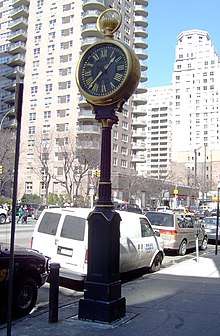
Around the late 1920s, Yorkville's ethnic diversity was beginning to wane. In 1926, the New York Times wrote of Yorkville's changing ethnic makeup:
Yorkville, for well-nigh two decades known to connoisseurs of east side life as the exclusive domain of Czechoslovaks, Hungarians and Germans, is slowly giving up its strongly accentuated Central European character and gradually merging into a state of colorless impersonality…[10]
In 1928, a one-block section of Sutton Place north of 59th Street, and all of Avenue A north of that point, was renamed York Avenue to honor U.S. Army Sergeant Alvin York, who received the Medal of Honor for attacking a German machine gun nest during World War I's Meuse-Argonne Offensive.[22][23][24]
The dismantling of the Third Avenue El in 1955 led to the demolition of many mansions. This led to the acceleration of the exodus of Yorkville residents. Over the years, this trend continued. Thus, in the 1980s, a building for members of the German gymnastic society Turners, at the intersection of 86th Street and Lexington Avenue, was demolished. Cafe Mozart, on 86th Street between Second and Third Avenues, was also demolished. In their place were built high-rise residential complexes.[11][21]
By the turn of the 21st century, East 82nd Street was co-named St. Stephen of Hungary Way. The area from East 79th to 83rd Streets, spanning approximately four blocks east-west, is colloquially known as Little Hungary.[25]
Demographics

Based on data from the 2010 United States Census, the population of Yorkville was 77,942, an increase of 1,174 (1.5%) from the 76,768 counted in 2000. Covering an area of 319.14 acres (129.15 ha), the neighborhood had a population density of 244.2 inhabitants per acre (156,300/sq mi).[26]
The racial makeup of the neighborhood was 76.0% (59,233) White, 3.7% (2,858) African American, 0.1% (51) Native American, 9.3% (7,226) Asian, 0.0% (25) Pacific Islander, 0.3% (216) from other races, and 1.9% (1,466) from two or more races. Hispanic or Latino of any race were 8.8% (6,867) of the population.[27]
The racial composition of Yorkville changed moderately from 2000 to 2010. The most significant changes were the increase in the Asian population by 41% (2,117), the increase in the Hispanic / Latino population by 18% (1,024), and the decrease in the White population by 4% (2,201). The Black population increased by 2% (64) and remained small, as did the population of all other races, which increased by 11% (170).[28]
The median income for a household in Yorkville is almost twice the average for the city, at $85,724.[29]
Police and crime
Yorkville is patrolled by the 19th Precinct of the NYPD, located at 153 East 67th Street.[30] The 19th Precinct ranked 14th safest out of 69 patrol areas for per-capita crime in 2010.[31]
The 19th Precinct has a lower crime rate than in the 1990s, with crimes across all categories having decreased by 84.5% between 1990 and 2019. The precinct reported 0 murders, 18 rapes, 171 robberies, 138 felony assaults, 223 burglaries, 1,658 grand larcenies, and 65 grand larcenies auto in 2019.[32]
Fire safety

Yorkville is served by two New York City Fire Department (FDNY) fire stations:[33]
Post offices and ZIP Codes
Yorkville is located in three primary ZIP Codes. From north to south, they are 10075 (between 76th and 80th Streets), 10028 (between 80th and 86th Streets), and 10128 (north of 86th Street). In addition, 500 East 77th Street in Yorkville has its own ZIP Code, 10162.[36] The United States Postal Service operates three post offices in Yorkville:
Education
Schools and higher education
The New York City Department of Education operates several public schools in the area.
The City University of New York has its administrative offices in Yorkville.[40] In addition Fordham Graduate Housing is located on East 81st Street between York and East End Avenues.[41]
The Lycée Français de New York is located on East 75th Street between York and East End Avenues. Further north, East Side Middle School is located on 91st Street between First and Second Avenues. The Trevor Day School is located four blocks north, on 95th Street between First and Second Avenues.
Libraries
The New York Public Library (NYPL) operates two branches near Yorkville. The Yorkville branch is located at 222 East 79th Street. The branch, a Carnegie library, opened in 1902 and was renovated in 1986–1987. The three-story space is listed on the New York State Register of Historic Places and the National Register of Historic Places.[42] The Webster branch is located at 1465 York Avenue. The branch was founded in 1893 as the Webster Free Library, and the current Carnegie library structure opened in 1906.[43]
Transportation
The New York City Subway's 86th Street and 96th Street stations, served by the Second Avenue Subway (Q train), serve much of Yorkville.[44] Meanwhile, Western Yorkville is served by 77th Street, 86th Street and 96th Street stations on the IRT Lexington Avenue Line (6 and <6> trains),[44] one block west of Yorkville's western boundary at 3rd Avenue.[45] The bus routes M15, M15 SBS, M31, M72, M79 SBS, M86 SBS, M96, M98, M101, M102, M103 of the New York City Bus also operate in Yorkville.[46]
Formerly, Eastern Yorkville was very far from any subway connections, and had among the farthest walks in Manhattan to any subway stations.[12] From 2007 to 2017, the Metropolitan Transportation Authority built the Second Avenue Subway's 86th Street and 96th Street stations, leading to increased residential construction and real estate prices in advance of the opening of the new subway line.[47]
Yorkville is served by NYC Ferry's Soundview route, which stops at 92nd Street.[48] The service started operating on August 15, 2018.[49][50]
Prominent locations
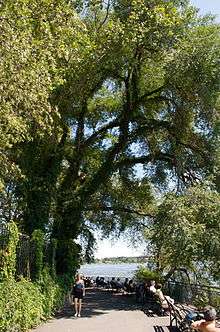
- Carl Schurz Park is a park on the far east side of Yorkville, adjacent to the East River.
- Gracie Mansion is the official home of the mayor of New York City.
- The Manhattan Chamber of Commerce was founded in Yorkville circa 1920, founded by 11 local businessmen.[51]
- The Municipal Asphalt Plant was constructed in 1941.[52] Asphalt Green, a fitness center, opened in the building in 1984.[53]
- The 91st Street Marine Transfer Station[54] is a controversial waste transfer plant next to Asphalt Green, on York Avenue. The waste facility was supported by New York City mayors Bill de Blasio[55] and Michael Bloomberg. The waste facility has been criticized by some area residents.[56]
- On 86th Street and 3rd Avenue the first Papaya King opened in 1932, and it is still in operation today.
- 92nd Street Y is a cultural and community center.
- 225 East 86th Street is a well-known condominium in the area.
- Ruppert Yorkville Towers were built as an urban renewal project on the site of the old Ruppert Brewery, which closed in the 1960s. It is a two-building complex stretching from 90th to 92nd Streets, between Second and Third Avenue.[57]
Notable residents
Residents of Yorkville have included:
- Bob Cousy (born 1928), professional basketball player[58]
- James Cagney (1899–1986), actor, grew up in the neighborhood.[17]
- Lou Gehrig (1903–1941), Major League Baseball player, was born at 309 East 94th Street.[59]
- August 'Gus' Gennerich (1887–1936), bodyguard to Franklin D. Roosevelt.[60]
- Ignatz Theodor Griebl (born 1899), German-American physician and a recruiter for the German spy network in New York City.[61]
- Norma Kamali (born 1945), fashion designer, grew up and went to school in Yorkville[62]
- Helmut Krone (1925–1996), art director who was considered to be a pioneer of modern advertising.[63]
- Bert Lahr (1895–1967), actor best known for playing the role of the Cowardly Lion in the 1939 film The Wizard of Oz[64][65]
- The Marx Brothers, comedians, lived at 179 East 93rd Street.[66][67]
- Henry Miller (1891–1980), author, was born in Yorkville.[68]
- John P. Morrissey (1885–1966), electrical engineer and politician who served in both houses of the New Jersey Legislature.[69]
- U.S. President Barack Obama (born 1961), lived in the early 1980s at 339 East 94th Street, before and after his graduation from Columbia University.[70][71]
- Martin J. Scott (1865–1954), Jesuit author, a priest at St. Ignatius Loyola Church from 1902 to 1915
- Georgette Seabrooke (1916–2011), muralist, artist, illustrator, art therapist, non-profit chief executive and educator, who is best known for her 1936 mural, Recreation in Harlem at Harlem Hospital Center.[72]
- Robert F. Wagner (1877–1953), U.S. Senator, after whom the middle school at 220 East 76th Street is named.[73]
- Multiple mayors have lived at Gracie Mansion.
In popular culture
- In the novels The Godfather Returns and The Godfather's Revenge by Mark Winegardner, Michael Corleone's penthouse is in Yorkville.[74]
- The children's book series by Bernard Waber starring Lyle the Crocodile started in 1962 with The House on East 88th Street, set in Yorkville.
- The apartment of Barney Stinson from popular sitcom How I Met Your Mother is located in Yorkville.
Gallery
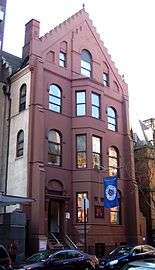 The Rhinelander Children's Center, of the Children's Aid Society
The Rhinelander Children's Center, of the Children's Aid Society- Church of St. Monica on 79th Street
- Church of St. Elizabeth of Hungary on 83rd Street
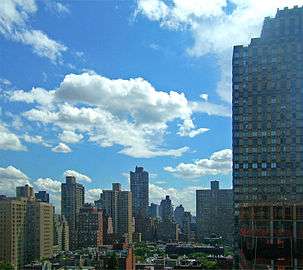 View of Yorkville at 86th Street
View of Yorkville at 86th Street Parade of German American Bund held on October 30, 1939, on 86th Street.
Parade of German American Bund held on October 30, 1939, on 86th Street.
References
- "NYC Planning | Community Profiles". communityprofiles.planning.nyc.gov. New York City Department of City Planning. Retrieved March 18, 2019.
- "Yorkville neighborhood in New York". Retrieved August 13, 2018.
- Hughes, C. J. (June 1, 2008). "Living in Yorkville: Where Change Is Underfoot, and Overhead". The New York Times. Retrieved July 12, 2013.
- LLC, Historic Map Works. "Map - Page 1, Atlas: The Seat of Action Between the British and American Forces.... Long Island, Historical Map". www.historicmapworks.com.
- McCullough, David (2006), 1776, New York: Simon and Schuster Paperback, ISBN 0-7432-2672-0
- "Search results - NYPL Digital Collections". digitalcollections.nypl.org.
- "Happy Birthday to the New York & Harlem Railroad – 180 years!". I Ride The Harlem Line. April 25, 2011.
- "Sheet 14: [Bounded by E. Ninety Second Street, Avenue A, E. Nintieth Street, Avenue B, E. Seventy Second Street, Avenue A, [E. Fifty Ninth Street] and 5th Avenue.]". NYPL Digital Collections.
- Croton-On-Hudson Historical Society (2001). Images of America Series. Arcadia Publishing. pp. 41, 128. ISBN 0738505439.
- "Yorkville Bank: Early History and Development of Yorkville" (PDF). Landmarks Preservation Commission. Archived from the original (PDF) on January 27, 2013. Retrieved 2013-01-12.
- Jackson, Kenneth T., ed. (2010). The Encyclopedia of New York City (2nd ed.). New Haven: Yale University Press. ISBN 978-0-300-11465-2., p. 1428
- "Yorkville vs. Park Slope: See how these New York City neighborhoods stack up". NY Daily News. December 12, 2013. Retrieved February 27, 2015.
- Gerald Handel (2000). Making a Life in Yorkville: Experience and Meaning in the Life-Course Narrative of an Urban Working-Class Man. Contributions in Sociology Series, 130; ABC-Clio ebook. Greenwood Publishing Group. pp. 1, 149. ISBN 0313313075.
- King, Gilbert. "A Spectacle of Horror – The Burning of the General Slocum; The deadliest disaster in New York before 9/11 killed many women and children and ultimately erased a German community from the map of Manhattan.", Smithsonian magazine, February 21, 2012. Accessed May 18, 2016. "The men of Little Germany were suddenly without families. Funerals were held for more than a week, and the desolate schoolyards of Kleindeutschland were painful reminders of their loss. Many widowers and broken families moved uptown to Yorkville to be closer to the scene of the disaster, establishing a new Germantown on Manhattan’s Upper East Side."
- Collins, Glenn (June 8, 2004). "A 100-Year-Old Horror, Through 9/11 Eyes; In the Sinking of the Slocum, a Template For the Arc of a City's Grief and Recovery". The New York Times. Retrieved November 20, 2007.
The disaster helped accelerate the flight of Germans from the Lower East Side to Yorkville and other neighborhoods, although there were other motivations as well. 'The very dense old housing on the Lower East Side was no longer attractive to upwardly mobile Germans,' said Dr. John Logan, director of the Center for Social and Demographic Analysis at the State University of New York at Albany.
- Strausbaugh, John (September 14, 2007). "Paths of Resistance in the East Village". The New York Times. Retrieved December 29, 2007.
On June 15, 1904, about 1,200 people from St. Mark's Evangelical Lutheran Church (323 Sixth Street, between First and Second Avenues, the site of the Community Synagogue since 1940) died when the steamship the General Slocum, taking them on a day trip up the East River, burned. It was the deadliest disaster in the city before Sept. 11, 2001. It traumatized the community and hastened residents' flight to uptown areas like Yorkville.
- Noble, Barbara Presley (July 23, 1989). "If You're Thinking of Living In: Yorkville". The New York Times. Retrieved July 31, 2010.
- David W. Dunlap (April 19, 2008). "In the Heart of Yorkville, Life Has Changed for German Catholics". The New York Times. Archived from the original on January 27, 2013. Retrieved January 12, 2013.
- "The History of Yorkville" by Kathryn A. Jolowicz
- "A Guide To The NYC St. Patrick's Day Parade", CBS New York, March 15, 2013
- "Letters; Yorkville Recalled". The New York Times. July 3, 1983. Retrieved July 31, 2010.
- Gray, Christopher. " Streetscapes/Sutton Place, Sutton Place South and One Sutton Place North; A Prestigious Enclave With a Name in Question", The New York Times, September 21, 2003. Accessed December 27, 2007.
- Pollak, Michael. "F. Y. I.", The New York Times, August 7, 2005. Accessed October 16, 2007. "In 1928, Sutton Place from 59th to 60th Street, and Avenue A north of 60th, were renamed York Avenue in honor of Sgt. Alvin C. York (1887–1964), a World War I hero from Tennessee and a recipient of the Medal of Honor."
- During his attack on October 8, 1918, York captured four German officers and 128 men and several guns. "Medal of Honor Recipients – World War I". United States Army Center of Military History.
- "Little Hungary", Forgotten New York
- Table PL-P5 NTA: Total Population and Persons Per Acre – New York City Neighborhood Tabulation Areas*, 2010, Population Division – New York City Department of City Planning, February 2012. Accessed May 18, 2016.
- Table PL-P3A NTA: Total Population by Mutually Exclusive Race and Hispanic Origin – New York City Neighborhood Tabulation Areas*, 2010, Population Division – New York City Department of City Planning, March 29, 2011. Accessed May 18, 2016.
- "Race / Ethnic Change by Neighborhood" (Excel file). Center for Urban Research, The Graduate Center, CUNY. May 23, 2011. Retrieved March 21, 2020.
- "Yorkville neighborhood in New York, New York (NY)". city-data.com. Retrieved January 12, 2013.
- "NYPD – 19th Precinct". www.nyc.gov. New York City Police Department. Retrieved October 3, 2016.
- "Upper East Side, Central Park – DNAinfo.com Crime and Safety Report". www.dnainfo.com. Retrieved October 6, 2016.
- "19th Precinct CompStat Report" (PDF). www.nyc.gov. New York City Police Department. Retrieved March 21, 2020.
- "FDNY Firehouse Listing – Location of Firehouses and companies". NYC Open Data; Socrata. New York City Fire Department. September 10, 2018. Retrieved March 14, 2019.
- "Engine Company 44". FDNYtrucks.com. Retrieved March 14, 2019.
- "Engine Company 22/Ladder Company 13/Battalion 10". FDNYtrucks.com. Retrieved March 14, 2019.
- "Upper East Side, New York City-Manhattan, New York Zip Code Boundary Map (NY)". United States Zip Code Boundary Map (USA). Retrieved March 24, 2019.
- "Location Details: Cherokee". USPS.com. Retrieved March 7, 2019.
- "Location Details: Gracie". USPS.com. Retrieved March 7, 2019.
- "Location Details: Yorkville". USPS.com. Retrieved March 7, 2019.
- "Administrative Offices." City University of New York. Retrieved on May 4, 2010.
- History of The Upper East Side and Yorkville, visitmanhattanapartments.com
- "About the Yorkville Library". The New York Public Library. May 10, 1907. Retrieved March 23, 2019.
- "About the Webster Library". The New York Public Library. May 10, 1907. Retrieved March 23, 2019.
- "Subway Map" (PDF). Metropolitan Transportation Authority. October 21, 2019. Retrieved January 18, 2018.
- "Road Map of Manhattan, New York". aaccessmaps.com. Archived from the original on January 19, 2013. Retrieved January 12, 2013.
- "Manhattan Bus Map" (PDF). Metropolitan Transportation Authority. December 2017. Retrieved April 24, 2018.
- Hughes, C.J. "Yorkville Bets on the Second Avenue Subway", The New York Times, April 8, 2016. Accessed May 18, 2016. "But the new subway stations at East 72nd, East 86th and East 96th Streets, and the expanded one at East 63rd, seem to be having an equalizing effect on prices in what used to be more of a cotton socks district."
- DNAinfoNewYork. "Proposed Routes for NYC's Expanded Ferry Service". Scribd. Retrieved September 22, 2016.
- Creag, Katherine (August 15, 2018). "New Yorkers Have a New, $2.75 Way to Get Around NYC". NBC New York. Retrieved August 29, 2018.
- Rivoli, Dan (August 15, 2018). "Setting sail from Soundview in new NYC ferry". nydailynews.com. Retrieved August 29, 2018.
- "History of the Manhattan Chamber of Commerce". October 20, 2009. Archived from the original on November 13, 2010. Retrieved October 20, 2009.
- Marjorie Pearson and Elizabeth Spencer-Ralph (October 1978). "National Register of Historic Places Registration: Municipal Asphalt Plant". New York State Office of Parks, Recreation and Historic Preservation. Archived from the original on October 19, 2012. Retrieved March 25, 2011. See also: "Accompanying two photos". Archived from the original on April 2, 2015.
- Allon, Janet (March 2, 1997). "Asphalt Green Gym Is Nearly All Roof, and It's Leaky" – via NYTimes.com.
- NYC East 91st Waste Facility Archived April 18, 2012, at the Wayback Machine
- "After deliberation, de Blasio supports the Upper East Side waste facility again". Capital New York. May 31, 2013. Retrieved February 27, 2015.
- "Opponents to File Lawsuit in Fight Against E 91st Street Trash Facility". DNA Info. July 25, 2012. Archived from the original on March 12, 2015. Retrieved February 27, 2015.
- "Ruppert Yorkville Towers". Ruppert Yorkville Towers. Retrieved April 22, 2020.
- Lubasch, Arnold H. (February 26, 1961). "Cousy Is Considering Retirement". The New York Times. p. S7. Retrieved July 31, 2010.
- "Plaque for Gehrig's Birthplace". The Miami News. Associated Press. August 22, 1953. Retrieved November 14, 2014.
- Rowley, Hazel (2011). Franklin and Eleanor: An Extraordinary Marriage. Melbourne University Publishing. p. 212. ISBN 9780522851793. Retrieved November 7, 2018.
- Kahn, David. Hitler's Spies: German Military Intelligence in World War II, p. 327. Da Capo Press, 2000. ISBN 9780306809491. Accessed May 20, 2016. "He was Ignatz T. Griebl, a bespectacled physician who was one of the most notorious womanizers in, and a leader of, Manhattan's German colony of Yorkville."
- "Longtime Fashion Designer Norma Kamali Infuses Her Work With Accessibility, Empowerment" Archived December 26, 2013, at the Wayback Machine by Budd Mishkin, One On 1, April 30, 2012
- Bierut, Michael. "Helmut Krone, Period.", Design Observer, August 23, 2006. Accessed May 20, 2016. "Challis's book is filled with this kind of detail. Born in 1925 to immigrant parents in Yorkville, Manhattan's German enclave, he attended the High School for Industrial Art, where he hoped to become a product designer."
- |19820/Bert-Lahr/ "Bert Lahr", Turner Classic Movies
- "Comedy Wizard Dies At 72", St. Petersburg Times, December 5, 1967. Accessed May 20, 2016. "Born Bert Lahrheim to an immigrant German family in New York's Yorkville section, Lahr dropped out of school at 15 and joined a child vaudeville troupe."
- Strausbaugh, John (December 14, 2007). "In the Mansion Land of the 'Fifth Avenoodles'". The New York Times. Retrieved January 30, 2008.
- Marx, Harpo (1962). Harpo Speaks!. Limelight Editions. ISBN 0-87910-036-2.
- Whitman, Alden. "Henry Miller, 88, Dies in California; A Credo of Hedonism Henry Miller, the Writer, Is Dead at 88 Travel Book Praised Some Tender Moments Books Outraged Many 'Just a Brooklyn Boy' Lamentations for Culture 'I Just Start Something'", The New York Times, June 9, 1980. Accessed May 20, 2016. "Henry Valentine Miller was born in the Yorkville section of Manhattan on Dec. 26, 1891, the son of a German-American tailor."
- "JOHN P. MORRISSEY, LEGISLATOR, DIES; Yorkville Democrat Served in Assembly and Senate", The New York Times, October 31, 1966. Accessed May 20, 2016. "Mr. Morrisey, an engineer, had been a Democratic district leader in Yorkville 35 years and had represented the area in the Assembly."
- Lee, Jennifer 8. (January 30, 2008). "Where Obama Lived in 1980s New York". The New York Times. Retrieved January 30, 2008.
- John Freeman Gill (November 16, 2012). "More Small Dogs and Big Home Prices". The New York Times. Archived from the original on January 27, 2013. Retrieved January 12, 2013.
- Georgette Seabrook Powell, The HistoryMakers, November 8, 2006. Accessed May 20, 2016. "Art therapist, non-profit chief executive, and painter Georgette Ernestine Seabrooke Powell was born on August 2, 1916 in Charleston, South Carolina to Anna and George Seabrooke. Powell grew up in the Yorkville neighborhood of New York City."
- Adams, Frank S. "End Papers: SENATOR ROBERT F. WAGNER and the Rise of American Liberalism. By J. Joseph Huthmacher. 362 pages. Atheneum. $10.", The New York Times, December 20, 1968. Accessed May 20, 2016. " How Bob Wagner, who came here as a boy of 9 from his native Germany and grew up in Yorkville, where his father was a janitor, became one of the key members of the New Deal and helped shape the basic labor-industrial relationships that still exist today is told in great detail in this sound but not very lively book by a Rutgers history professor."
- Puzo, Mario. The Godfather's Revenge. p. 94. Retrieved October 20, 2009.
External links
![]()